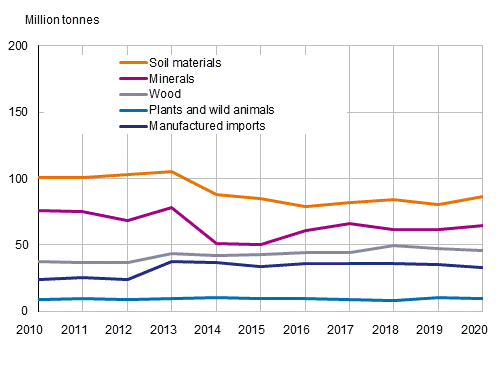Published: 18 November 2021
Mining of minerals and soil materials increased domestic material consumption in 2020
A total of 184 million tonnes of natural resources were taken into use in Finland in 2020 Domestic material consumption grew by close on five per cent from the previous year and the volume was highest since 2013. The growth was particularly due to increased use of minerals and soil materials – their combined share of direct inputs of natural resources was 63 per cent.
Table 1. Domestic material consumption 2010 - 2020
| million tonnes | 2010 | 2011 | 2012 | 2013 | 2014 | 2015 | 2016 | 2017 | 2018 | 2019 | 2020 |
| Domestic direct inputs | 187 | 186 | 185 | 215 | 170 | 167 | 172 | 180 | 180 | 178 | 184 |
| Foreign direct inputs | 60 | 62 | 56 | 58 | 57 | 53 | 57 | 56 | 60 | 57 | 54 |
| Exports | 42 | 44 | 44 | 45 | 45 | 42 | 44 | 45 | 49 | 50 | 46 |
| Domestic material consumption | 204 | 203 | 197 | 229 | 183 | 179 | 185 | 191 | 191 | 184 | 193 |
Altogether 184 million tonnes of domestic natural resources were utilised in 2020. Domestic direct inputs refer to materials extracted from domestic nature, and when inputs imported from abroad as raw materials or processed products are added to them and exports are subtracted, domestic material consumption is derived, which is one of the UN’s indicators for sustainable development. Both imports and exports of materials decreased from the previous year.
Domestic material consumption was 193 million tonnes in 2020. This was nearly five per cent more than in 2019, when domestic material consumption had diminished especially as a result of a decrease in soil extraction. The figure for 2020 was higher than at any time since 2013: the growth was based on an increase in domestic direct inputs.
Material requirement as direct inputs by material group in 2010 to 2020, million tonnes

In 2020, the volume of soil materials and minerals increased from direct inputs, i.e. natural resources taken into use from Finland and abroad, to over 150 million tonnes. In turn, the volumes of wood, plants and wild animals, as well as imported processed products decreased. Thirty-six per cent of the direct inputs were soil materials, 27 per cent minerals and 23 per cent wood and other plants and wild animals. The import volumes fell, especially due to decreased imports of fossil energy materials, such as hard coal and crude oil. The decrease in exports was affected by changes in the volumes of wood and exported processed products.
Source: Economy-wide material flow accounts 2020, Statistics Finland
Inquiries: Heidi Pirtonen 029 551 3093, environmental.accounts@stat.fi
Head of Department in charge: Katri Kaaja
Publication in pdf-format (212.1 kB)
- Tables
-
Tables in databases
Pick the data you need into tables, view the data as graphs, or download the data for your use.
Appendix tables
Updated 18.11.2021
Official Statistics of Finland (OSF):
Economy-wide material flow accounts [e-publication].
ISSN=2242-1289. 2020. Helsinki: Statistics Finland [referred: 21.12.2025].
Access method: http://stat.fi/til/kanma/2020/kanma_2020_2021-11-18_tie_001_en.html

